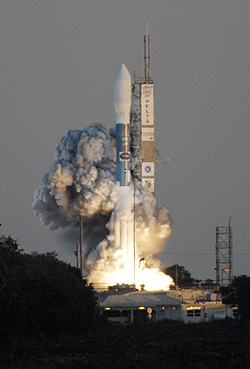Berkeleyan
 |
THEMIS project manager Peter Harvey (far left) and principal investigator Vassilis Angelopoulos in the Mission Director's Center at Cape Canaveral a few hours before the planned Feb. 16 launch of the satellites, which was scrubbed eight minutes before liftoff. (Robert Sanders photo) |
Berkeley, we have no problems!
Successful launch of THEMIS satellites positions NASA mission to answer key questions about Earth's auroras
![]()
| 21 February 2007
After a picture-perfect launch into clear, blue skies, five Berkeley-designed and -built space probes are healthy and in their expected orbits. The THEMIS probes, mounted atop a Delta II rocket, were launched from Pad 17-B at Cape Canaveral Air Force Station, Fla. at 6:01 p.m. EST on Saturday, Feb. 17. The spacecraft separated from the launch vehicle approximately 73 minutes after liftoff.
 A Delta II launches the THEMIS spacecraft. (Photo courtesy NASA) |
By 8:07 p.m., after the five probes had flown over Berkeley's ground-based radio antenna, campus-based mission operators commanded and received signals from all five spacecraft, confirming that they had separated properly from the carousel that Swales Aerospace had designed to fling them into orbit.
While only two were confirmed healthy on the constellation's first flight over the ground antenna, the other three were confirmed healthy on the second flyover.
THEMIS, which stands for Time History of Events and Macroscale Interactions during Substorms, is NASA's first five-satellite mission and the first to investigate a key mystery surrounding the auroras, or Northern and Southern lights: When, where, and how are they triggered?
The satellites won't be in a position to answer this question until next winter, because they must coast into the proper orbits to allow them to detect electrical activity in space and link this to auroral outbursts via a network of 20 ground observatories spanning Canada and Alaska. Until then, THEMIS will collect data that will help improve our understanding of the Van Allen radiation belts surrounding Earth; the data will also show how energy from the sun enters Earth's magnetic field on the daytime side and is funneled to the nighttime side to create auroras.
The findings from the mission may help protect commercial satellites and humans in space from the adverse effects of particle radiation.
For information about and imagery of the THEMIS mission, visit www.nasa.gov/themis; the THEMIS mission website is at ds9.ssl.berkeley.edu/themis.

